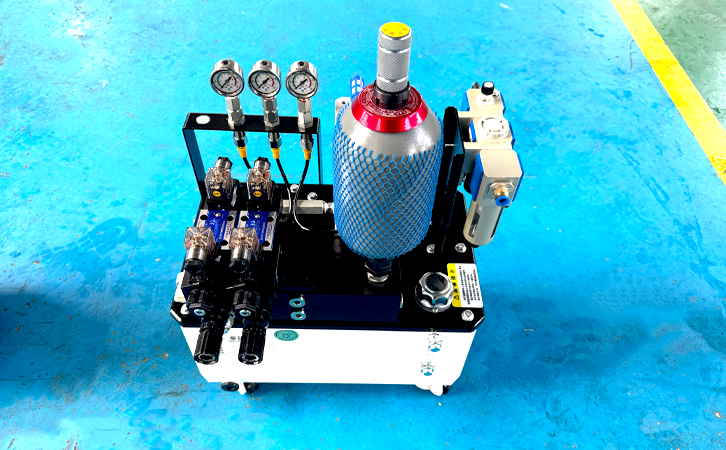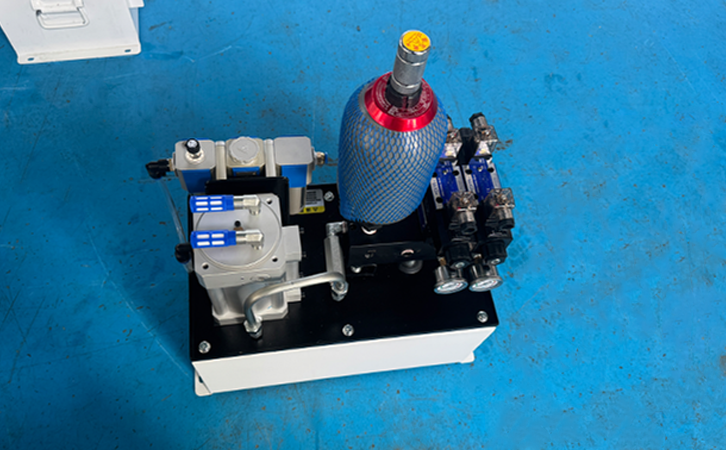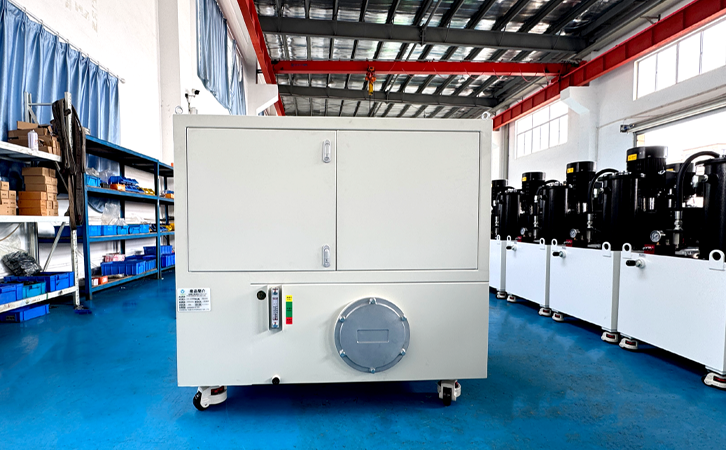Welcome, Yangyu Hydraulic Production and CNCHydraulic stationKnife cylinderCentral effluent filtration systemHigh pressure flushing equipment! Tel: 400-019-6868
Welcome, Yangyu Hydraulic Production and CNCHydraulic stationKnife cylinderCentral effluent filtration systemHigh pressure flushing equipment! Tel: 400-019-6868







Answer: After the hydraulic station oil leaks, the following measures should be taken immediately to deal with it:
1. Question: What is the first step?
Answer: Close the valve. When oil leakage occurs in the hydraulic station, the valve should be immediately closed to stop the flow of hydraulic oil and prevent more hydraulic oil leakage. Closing the valve can also reduce the pressure inside the hydraulic station and lower the risk of oil leakage. Before closing the valve, make sure to shut down and cut off the main power supply.
2. Question: What is the second step?
Answer: Clean up the site. Once oil leakage is found in the hydraulic station, the site should be cleaned immediately to prevent oil contamination from spreading and causing larger accidents. During the cleaning process, appropriate protective equipment and tools should be used to ensure the safety of personnel. At the same time, the leaked hydraulic oil should be collected and properly disposed of to avoid polluting the environment.
3. Question: What is the third step?
Answer: Check for damage. After the hydraulic station oil leaks, the damage should be checked immediately for timely repair. Firstly, it is necessary to inspect the equipment and pipelines of the hydraulic station for wear, cracks, and other issues, in order to determine the specific location of the leak. Then, corresponding measures should be taken based on the damage situation, such as replacing damaged pipelines or equipment.
Question 4: What is the fourth step?
Answer: Strengthen safety management. The safety management of hydraulic stations is the key to avoiding oil leaks. Equipment and pipelines should be regularly inspected for foreign objects, damage, aging, and other issues, and maintenance should be strengthened to ensure their integrity. At the same time, professional training and assessment should be provided to the operators of the hydraulic station to improve their operational skills and safety awareness, in order to reduce unnecessary accidents.
Conclusion: Hydraulic station oil leakage is a common safety accident that poses a threat to equipment, environment, and personnel safety. Therefore, during the operation of the hydraulic station, it is necessary to strengthen safety management, regularly inspect the condition of equipment and pipelines, and strictly follow the operating procedures to operate the equipment. Once an oil leak occurs, immediate measures should be taken to ensure the safe operation of the hydraulic station.
Q: What are the reasons for the high oil temperature in the hydraulic station?
Answer: The main reasons for the high oil temperature in hydraulic stations include:
1. Overloading of the hydraulic system results in excessive friction and energy loss, leading to an increase in oil temperature
2. Excessive or insufficient hydraulic oil increases friction and energy loss, or the circulation speed of the oil in the system increases, making it difficult to dissipate heat in a timely manner
3. Oil contamination, such as impurities, moisture, or gas mixing, increases the friction of the oil, leading to an increase in oil temperature
4. Leakage in the system leads to oil loss, reducing the lubrication and cooling effectiveness of the system
5. Oil aging leads to a decrease in oil performance and thermal conductivity over time
6. Poor heat dissipation of hydraulic system, such as radiator or cooler not working or poor heat dissipation effect.
Q: How to deal with high oil temperature in hydraulic stations?
Answer: The processing methods include:
1. Check the oil system of the hydraulic station, remove blockages or replace components with high resistance to ensure smooth oil flow
2. Reasonably adjust the working load of the hydraulic station to avoid overloading and reduce friction losses
3. Regularly inspect and maintain the cooling system of the hydraulic station to ensure good cooling effect of the radiator. Consider increasing the number of radiators or enhancing their cooling capacity
4. Regularly check and replace the oil in the hydraulic station to avoid oil contamination affecting friction and reduce heat generation
5. In high temperature environments, cooling devices for hydraulic systems can be added, such as adding fans or installing coolers, to improve heat dissipation efficiency
6. During use, pay attention to controlling the working time and load of the hydraulic system to avoid excessive use leading to high oil temperature.
Through the above measures, the problem of high oil temperature in the hydraulic station can be effectively solved, ensuring the normal operation of the hydraulic system and extending its service life.
**问:hydraulic system中振动和噪音的主要来源有哪些?**
答:液压系统中的振动和噪音主要来源于以下几个方面:
1. **安装不当**:如管道支撑不良、基础缺陷、液压泵与电机轴不同心或联轴节松动等问题。
2. **回转体不平衡**:电机通过联轴节驱动液压泵时,若回转体不平衡力过大,会导致转轴弯曲振动并产生噪声。
3. **液压泵吸入空气**:工作时吸入空气形成气泡,在高压区气泡破裂产生高频压力冲击,造成振动和噪音。
**问:如何消除液压系统的振动和噪音?**
答:消除液压系统振动和噪音的具体方法包括:
1. **确保泵吸油管密封**:防止吸入空气。
2. **优化管路设计**:避免管道截面突变,弯管曲率半径至少为管道直径的五倍,减少紊流和旋流。
3. **合理设计油箱**:预防液压阀空穴现象,采取措施减小泵的吸油阻力,如使用大直径吸油管、大容量吸油滤器,并定期清理滤油器,同时减小泵的吸油高度。
**问:上海扬誉液压科技有限公司提供哪些服务?**
答:上海扬誉液压科技有限公司专注于液压站设计与制造,提供以下服务:
- **液压站设计与非标定制**:根据客户需求设计专业液压系统方案。
- **液压系统制造**:涵盖液压泵站的设计与制造。
- **技术支持与服务**:包括现场安装、调试服务,拥有一支高技术、高素质的技术与管理团队,采用国外先进技术与工艺,确保产品品质,并能根据用户特定需求提供个性化解决方案。
-Pump not turning or running in reverse: Check electrical components, motor direction, connection keys, and hydraulic components (such as relief valves and one-way valves), and repair faults
-Pump shaft issue: Check if the pump shaft is broken, replace it if necessary, and disassemble and repair the sliding parts inside the pump to ensure that the assembly clearance meets the standards. At the same time, pay attention to the quality of the oil and the cooling condition
-The pump cannot absorb oil: Firstly, diagnose the oil absorption obstacle and solve it accordingly
-* * Decreased efficiency * *: Disassemble the pump body, clean, repair or replace worn parts, grind the oil distribution plate, update bearings and plungers, and reassemble to technical standards.
-* * Vacuum phenomenon * *: Clean or replace clogged filter screens, adjust suction pipe layout, and reinforce sealed connections
-* * Inhalation of air * *: No load exhaust operation, extend the suction pipe
-Mechanical wear: Check the wear of the bearings and components inside the pump, and repair and replace them in a timely manner.
-Installation issue: As above, ensure unobstructed oil suction path and strengthen sealing
-Bubble impact: Similarly, empty exhaust is adopted to optimize the oil suction system
-Oil contamination: Replace or filter the oil to ensure cleanliness.
-Improper assembly or oil problems: Check the assembly clearance, select qualified hydraulic oil, clean and replace contaminated oil
-Internal leakage and low efficiency: It is also necessary to disassemble, clean, replace worn parts, grind damaged parts, and ensure the internal sealing and working efficiency of the pump body.
In short,handle When a hydraulic pump malfunctions, the root cause of the problem should be accurately diagnosed first, and then targeted measures such as cleaning, adjusting, replacing parts, or optimizing system configuration should be taken to ensure that the hydraulic system returns to stable operation

Shanghai Yangyu Hydraulic Technology Co., Ltd.
Mainly engaged inDesign, R&D, production and transformation of servo hydraulic systems, variable frequency hydraulic systems, booster cylinders, cutting cylinders, customized hydraulic systems, central water filtration systems, high-pressure flushing systems, hydraulic power units and fluid filtration systems.



The company has many non-standard products, and the machine parameters vary according to customer needs. The specific parameters are subject to the transaction contract and nameplate! All real shots of the workshop on this website will not be authorized to be used by any third party!
Copyright © 2024All Rights ReservedShanghai Yangyu Hydraulic Technology Co., Ltd.Copyright Registration Number: Shanghai ICP No. 2023022013
 TeL
TeLTel:
400-019-6868
 technical advice
technical advice
 Online consultation
Online consultationOnline consultation
 Order products
Order productsContact us to provide you with exclusive services!
Go to top
